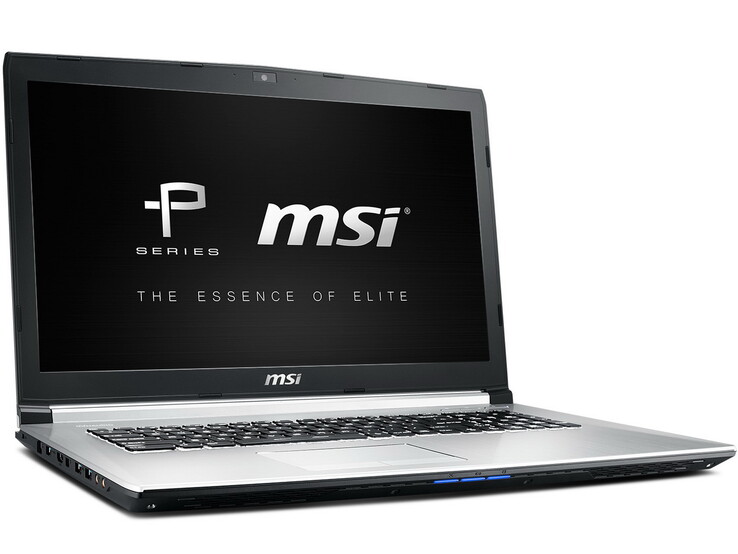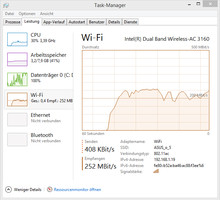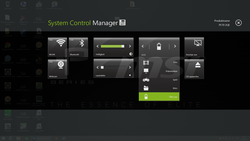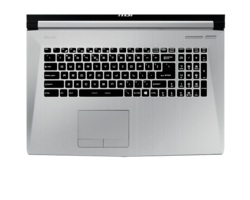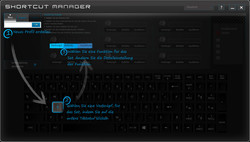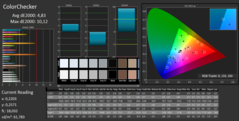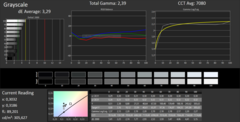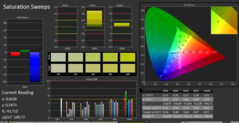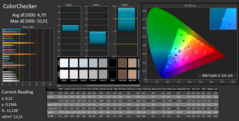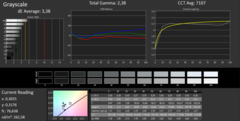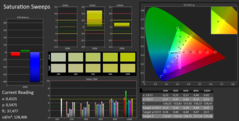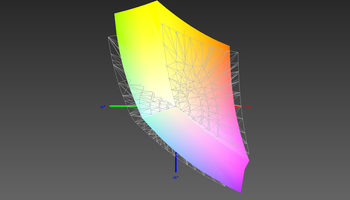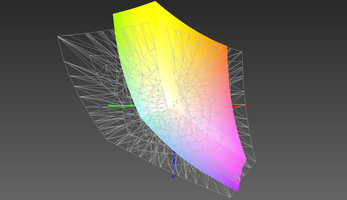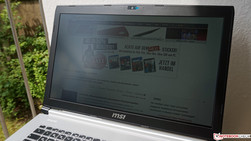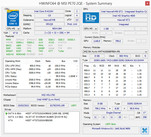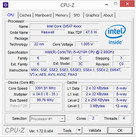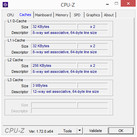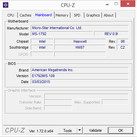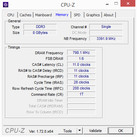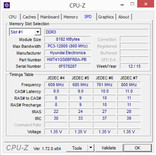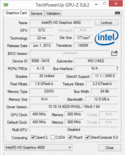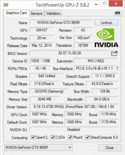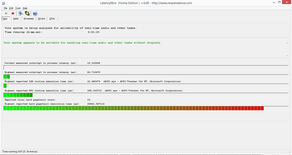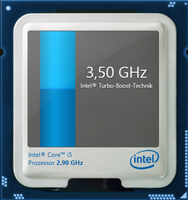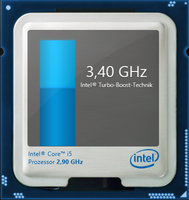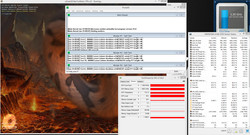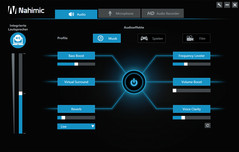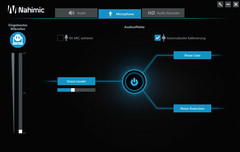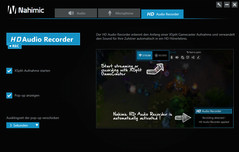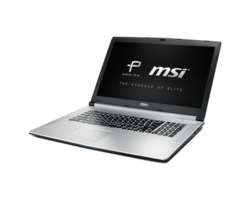MSI PE70 2QE Notebook Review
For the original German review, see here.
We already had a closer look at the display with the so-called "True Color Technology" in a preview article, and now we can test another model from the PE70-series. The device with the designation MSI PE70-2QEi581 represents the entry-level configuration for an RRP of 1,299 Euros (~$1430). However, you only get a dual-core Intel i5 processor as well as a conventional hard drive for this price. The situation is much better for the other components: Full HD IPS panel, AC Wi-Fi, 8 GB RAM and a 4.1 sound system. There are also other features that we would usually expect in a gaming notebook: Besides the powerful graphics card Nvidia GTX 960M, MSI also equips the notebook with a Killer network card as well as a SteelSeries keyboard. MSI also offers other configurations of the PE70 with quad-core processor and SSDs.
Rivals for the MSI PE70 are other multimedia notebooks like the Acer Aspire V Nitro 7 or the Asus N751JX. The Lenovo Y70 and the Asus GL771JM are suitable rivals as well. Contrary to the review unit, all competitors are equipped with quad-core processors, so we are already eager to see how the test model of the PE70 performs in our review.
Case
With its brushed aluminum surfaces, the PE70 leaves a really noble first impression. However, this material is only used for the top of the base unit as well as the display cover; the rest of the chassis is made of matte and black plastic. At the rear is a noble Prestige logo with a white stripe. The individual keys of the keyboard are directly integrated into the top of the base unit, similar to unibody constructions. You can find small design elements like slanted surfaces everywhere on the notebook, which results in a pretty playful appearance. This might already be too striking for business users, who also belong to the targeted customers according to MSI.
The PE70 is one of the lighter models in the 17.3-inch class at just 2.6 kg, but the stability cannot completely convince us. Except for the edges, it is possible to dent the whole top of the base unit, which will result in audible creaking. Pressure will also bend the base unit, so the bottom of the device touches the surface beneath, a table, for example. The display can be slightly twisted as well, but it does not immediately result in picture distortions. At least the build quality is okay, the gaps are even and there are no sharp edges. Only the right touchpad button is not perfectly integrated and sits a bit lower, so there is a height difference between the two buttons. The two display hinges are very firm and it is not possible to open the lid with one hand, but they still cannot prevent a certain amount of bouncing.
The MSI PE70 has three blue status lights at the lower front. They look nice on product pictures, but they are located pretty deep in the construction, so you cannot see them in operation. A maintenance hatch is not available, but it is no big problem to remove the whole bottom cover. The battery is fixed inside the case and cannot be accessed from the outside.
All in all, the quality could have been better; especially the problems with the stability cannot meet the high quality claim.
Connectivity
There are no surprises in respect of the ports. It is possible to use the two digital-video outputs (HDMI, Mini-DisplayPort) in addition to the internal display via MSI’s Matrix Technology, which means you can drive 3 displays at the same time. Two stereo jacks are available for high-quality headsets (1x headphones & 1x microphone). All the ports are distributed across the sides of the case, but the majority is located at the left, which might be a problem when left-handers want to use an external mouse. The ports themselves have enough room, so you do not have to worry about blocked adjacent ports.
Communication
MSI equips the PE70 with a Killer network card from Qualcomm Atheros, which is a good thing for gamers. The simple software can be used to prioritize applications, which is supposed to result in lower ping times. The PE70 can obviously communicate with wireless networks as well. The familiar Intel Dual-Band Wireless AC-3160 supports the fast AC standard, but only with a maximum transfer rate of 433 Mbps. We managed around 260 Mbps in practice (2 meters from the router Asus RT-AC56U; 802.11n ~62 Mbps). The connection was very stable during the whole review period and there were no unexpected dropouts. The Intel module also supports Bluetooth 4.0 and we had no problems using an external mouse.
Above the display is an HD webcam, but the quality is disappointing. MSI only uses an HD module with the maximum resolution of 1280x720 pixels. The quality might be sufficient for simple video chats, but that’s about it. Videos can also be recorded in HD (@30 fps), but you should use the smartphone if possible.
Security
According to MSI, the PE70 is also designed for business customers, but the features do not support that claim. You neither get a TPM chip, a fingerprint reader nor a SmartCard reader.
Accessories
Besides the 120-Watt power adaptor and some brochures, there are no more accessories in the appealing box of the MSI PE70. The manufacturer does not offer any special accessories on its homepage, either.
There are, however, some software additions with fancy names. It starts with the "System Control Manager," a simple interface with the most important settings like the brightness, the volume, the power profile and the wireless modules. "Shift" offers three different settings (Sport, Comfort, Green), but they do not have a big impact on the performance (more information later). We will come to the other software additions in the corresponding review sections.
Maintenance
There is no maintenance hatch on the bottom, but it is pretty easy to remove the whole bottom cover, despite the large number of screws. We did not open our shop device to avoid any damages.
You get a free memory slot (for a total of 16 GB) and you get access to the hard drive, the Wi-Fi adaptor and the M.2 slot. The fans also seem to be accessible according to the product pictures from MSI.
Warranty
Positive: Instead of the usual 24 months, you get a standard warranty period of 36 months including a Pickup & Return service.
Input Devices
Keyboard
Similar to the gaming notebooks from MSI, the PE70 also uses a SteelSeries keyboard. The layout did not change, either, so newcomers will have to get used to it first. There is a small gap between the regular keys and the numeric keypad, but the arrow keys (more precisely the right arrow key) extends into the numeric keypad. The biggest problem at the beginning, however, was the single-row Enter key.
The keys themselves mainly leave a positive impression. They are transparent and the surfaces are painted just in black. This means the three-stage while illumination works very well and the contrast is excellent. The font is a bit unusual, but you get used to that pretty quickly. The typing experience with the generous travel and the quiet as well as soft stroke is very convenient, but the stability can once again not convince us. The input can be pushed in, especially in the center. If we press the letter "G," for example, the adjacent keys will be slightly pushed down as well. This is pretty irritating and does not leave a very good impression. Above the standard keyboard are three dedicated special keys at the right side for the Power, the different True Color modes as well as the Cooler Boost.
MSI equips the PE70 with a Shortcut Manager, which can be used to create your own shortcuts. This is certainly handy for some applications and games and therefore an appreciated extra.
Touchpad
MSI does not use a ClickPad for the PE70 but a conventional touchpad with dedicated mouse buttons instead. The pad itself is slightly roughened, which is good for the precision. Multi-touch gestures are executed reliably, and there are comprehensive adjustability options in the Synaptics driver. The two mouse buttons appear pretty cheap with their loud clicking noise. It would have been better if the manufacturer had used buttons similar to the keyboard. An external mouse is definitely the better choice.
Display
The MSI PE70 is only available with a matte Full HD display (1920x1080). The 17.3-inch panel is based on IPS technology and our review unit uses a panel with the designation LP173WF4-SPF1 (LG Philips), which means it is identical to the panel from our preview article. That there are differences between panels from the same series is not surprising, but the differences between these two panels are significant.
While the maximum brightness at 305 cd/m² is still comparable, we only get a pretty sobering result of 79% for the brightness distribution. The luminance drops by up to 50 cd/m² at the top third of the panel, but this is, fortunately, hardly visible in practice. The black value is also much higher at 0.5 cd/m², which results in a contrast of just 610:1. The colors could be richer and the dark areas appear slightly grayish.
| |||||||||||||||||||||||||
Brightness Distribution: 79 %
Center on Battery: 245 cd/m²
Contrast: 610:1 (Black: 0.5 cd/m²)
ΔE ColorChecker Calman: 4.83 | ∀{0.5-29.43 Ø4.78}
ΔE Greyscale Calman: 3.29 | ∀{0.09-98 Ø5}
84% sRGB (Argyll 1.6.3 3D)
56% AdobeRGB 1998 (Argyll 1.6.3 3D)
61.9% AdobeRGB 1998 (Argyll 3D)
84.6% sRGB (Argyll 3D)
66.6% Display P3 (Argyll 3D)
Gamma: 2.39
CCT: 7080 K
| MSI PE70-2QEi581 GeForce GTX 960M, 4210H, Toshiba HG5d THNSNH256GMCT | Acer Aspire V Nitro 7-791G-70TW GeForce GTX 960M, 4720HQ, Kingston RBU-SNS8100S3256GD | Asus N751JX-T4056H GeForce GTX 950M, 4720HQ, Toshiba MQ01ABD100 | Lenovo Y70 DU004HUS GeForce GTX 860M, 4710HQ, Western Digital WD10S21X SSHD 1TB + 8GB SSD-Cache | Asus GL771JM GeForce GTX 860M, 4710HQ, Kingston RBU-SC100S37128GD | |
|---|---|---|---|---|---|
| Display | 4% | 15% | 4% | 6% | |
| Display P3 Coverage (%) | 66.6 | 70.1 5% | 76.8 15% | 69.2 4% | 71.8 8% |
| sRGB Coverage (%) | 84.6 | 87.5 3% | 97.6 15% | 87.8 4% | 88.7 5% |
| AdobeRGB 1998 Coverage (%) | 61.9 | 63.9 3% | 71.4 15% | 64.4 4% | 64.8 5% |
| Screen | -7% | -0% | 15% | -1% | |
| Brightness middle (cd/m²) | 305 | 347 14% | 337 10% | 329.5 8% | 336 10% |
| Brightness (cd/m²) | 265 | 326 23% | 312 18% | 325 23% | 309 17% |
| Brightness Distribution (%) | 79 | 90 14% | 86 9% | 91 15% | 84 6% |
| Black Level * (cd/m²) | 0.5 | 0.409 18% | 0.61 -22% | 0.381 24% | 0.41 18% |
| Contrast (:1) | 610 | 848 39% | 552 -10% | 865 42% | 820 34% |
| Colorchecker dE 2000 * | 4.83 | 6.81 -41% | 5.84 -21% | 4.45 8% | 7.21 -49% |
| Greyscale dE 2000 * | 3.29 | 7.27 -121% | 3.86 -17% | 3.45 -5% | 4.96 -51% |
| Gamma | 2.39 92% | 2.4 92% | 2.59 85% | 2.03 108% | 2.98 74% |
| CCT | 7080 92% | 7546 86% | 6859 95% | 6623 98% | 6572 99% |
| Color Space (Percent of AdobeRGB 1998) (%) | 56 | 57 2% | 64 14% | 57.81 3% | 58 4% |
| Color Space (Percent of sRGB) (%) | 84 | 97 15% | |||
| Total Average (Program / Settings) | -2% /
-4% | 8% /
3% | 10% /
12% | 3% /
1% |
* ... smaller is better
The MSI True Color technology provides several color profiles (Games, Anti-Blue, sRGB, Designer, Office and Cinema). Depending on the current profile, the user can adjust different parameters based on their personal preferences. We prefer an accurate color presentation, so we selected the sRGB profile for our measurements with the software CalMAN.
The results are already pretty decent ex-works: Compared to the sRGB reference color space, we can measure an average deviation of 4.83 (target value <3), which means the deviations are only visible to a trained eye. Many colors are also below 3, but orange and yellow are outliers with a DeltaE deviation of almost 10. Even better is the grayscale performance, where we can only measure an average deviation of 3.29. The performances in this section are much closer to the preview article and are generally satisfying. The panel cannot cover the whole sRGB color space (contrary to its smaller sibling PE60), but the results are normal within the comparison. A calibration did not really improve the results.
Even though the dimensions are not perfect for the mobility, the notebook would be actually well-suited for use outdoors thanks to its matte panel. However, the luminance is limited to 245 cd/m² on battery power, which is not enough for the comfortable visibility of content under direct sunlight in combination with the large panel. You should look for a place in the shade, because then there will be no limitations.
Performance
Our test model of the PE70 uses an i5 dual-core processor, 8 GB RAM as well as a conventional 1 TB hard drive. This means it falls behind other multimedia notebooks in this price range that are all equipped with a quad-core and with the exception of the Asus N751JX also a hybrid hard drive or SSD, respectively. We will see how this affects the performance in the following sections.
MSI also offers other configurations of the PE70 that differ in respect of the processor, the memory as well as the storage solution. Our entry-level configuration retails for 1,299 Euros (~$1430); the more powerful versions (Core i7, 16 GB, SSD+HDD) currently cost at least 1,500 Euros (~$1649).
Processor
Intel’s Core i5-4210H is a dual-core processor with a TDP of 47 Watts. The nominal clock of the Haswell chip is 2.9 GHz, but it can be raised to 3.5 GHz for one core and 3.4 GHz for two cores via Turbo Boost. Hyper-Threading is supported as well, which means the CPU can execute up to four threads simultaneously.
The processor can fully utilize its Turbo Boost potential. This means the chip can keep up with the quad-cores or even beat them in the Single-Core tests of the Cinebench-series. The Multi-Core benchmarks, however, determine the expected disadvantage (-39 up to -49% in Cinebench R15). Even when both processor cores are running at the maximum Turbo clock of 3.4 GHz, the processor only consumes around 32 Watts and is not even close to the specified TDP limit of 47 Watts.
The different profiles of MSI’s Shift feature have no effect on the processor performance. However, it looks like the manufacturer implemented a consumption limit on battery power (at around 20 Watts), so the Turbo Boost is not available when you stress both cores. It runs at 2.9 GHz, which results in 276 instead of the full 330 points in CB R15 Multi. The Turbo Boost is utilized when you only stress one core, but the clock will fluctuate between 3.2 and 3.4 GHz, which results in a slightly lower result (123 vs. 127 points in CB R15 Single).
More information and benchmarks of the processor are available in our Tech section.
System Performance
The system performance is one of the most important aspects, because we will notice problems in this category all the time. SSDs got more and more popular over the last few years, so even allegedly slow devices are subjectively pretty fast in practice. We were eager to see how the MSI PE70 with a conventional hard drive (7,200 rpm) performs.
The subjective impression of the system is decent. There will be delays when you boot the notebook or launch applications, but the device never felt too slow. The missing SSD obviously affects the PCMark results; PCMark 7 in particular benefits from fast flash storage, and our review unit cannot keep up with the SSD-based rivals.
The situation does, however, change in PCMark 8, because the test has other priorities: All rivals are pretty much on par, and our review unit can even take the lead in the Work test. This result is not only surprising because of the missing SSD but also because of the allegedly slower dual-core processor.
| PCMark 7 - Score (sort by value) | |
| MSI PE70-2QEi581 | |
| Acer Aspire V Nitro 7-791G-70TW | |
| Lenovo Y70 DU004HUS | |
| Asus GL771JM | |
| PCMark 8 | |
| Home Score Accelerated v2 (sort by value) | |
| MSI PE70-2QEi581 | |
| Asus N751JX-T4056H | |
| Lenovo Y70 DU004HUS | |
| Asus GL771JM | |
| Work Score Accelerated v2 (sort by value) | |
| MSI PE70-2QEi581 | |
| Asus N751JX-T4056H | |
| Lenovo Y70 DU004HUS | |
| Asus GL771JM | |
| PCMark 7 Score | 3126 points | |
| PCMark 8 Home Score Accelerated v2 | 3194 points | |
| PCMark 8 Work Score Accelerated v2 | 4407 points | |
Help | ||
Storage Devices
MSI equips the PE70 with a 1 TB hard drive from HGST (Travelstar 7K1000 HTS721010A9E630). The drive works with 7,200 revolutions per minute and manages sequential transfer rates of around 140 MB/s (read) and 125 MB/s (write). Those are very good results for an HDD, which also explains the good subjective impression. The more expensive configurations use an M.2 SSD as a system drive besides the HDD. You can also upgrade the entry-level configuration with an SSD, which would increase the subjective system performance even further.
More benchmarks and information about hard drives and SSDs are available in our comparison.
Graphics
The graphics during less demanding tasks like text editing, web browsing or video playback are handled by the integrated Intel HD Graphics 4600. The performance of the chip is easily sufficient for these applications, and even video editing can benefit from the very efficient Quick-Sync technology.
In addition to the integrated GPU, all versions of the PE70 are also equipped with a dedicated Nvidia GTX 960M GPU. It is automatically activated via Optimus technology, which works very well, but it is also possible to assign applications manually in the Nvidia driver if necessary. The clock of the mainstream graphics card is specified at 1097 MHz but can be raised to 1188 MHz via GPU Boost. The 2 GB GDDR5 video memory (128-bit) runs at 1,000 MHz. The technology of the chip with 640 CUDA cores is based on the predecessor GTX 860M, which is also noticeable in the synthetic benchmarks. The GTX 960M cannot establish an advantage, but this is also partly a result of the dual-core processor. The Acer Aspire Nitro with the same GPU is 11% faster in 3DMark 11, and even the two notebooks with a GTX 860M are 4% ahead of the PE70. Only the Asus N751JX with the GTX 950M is a bit slower (-6%).
Contrary to the processor, MSI’s Shift software has an effect on the GPU clock. While the full performance including Turbo Boost is available in the Sport mode, the GPU only runs at its nominal clock of 1,097 MHz in the Comfort mode. The performance is further reduced in the Green mode, where the GPU clock levels off at around 1,032 MHz, which obviously affects the performance. We could not notice any other differences between the individual modes (which are only available on mains power).
Similar to the processor we can see a performance limitation of the graphics card on battery power, because the GPU clock starts at 954 MHz and then levels off between 820-855 MHz. This means the gaming performance on battery power is limited.
More information and benchmarks of the Nvidia GTX 960M are available in our Tech section.
| 3DMark 11 - 1280x720 Performance (sort by value) | |
| MSI PE70-2QEi581 | |
| Acer Aspire V Nitro 7-791G-70TW | |
| Asus N751JX-T4056H | |
| Lenovo Y70 DU004HUS | |
| Asus GL771JM | |
| 3DMark - 1920x1080 Fire Strike Score (sort by value) | |
| MSI PE70-2QEi581 | |
| Acer Aspire V Nitro 7-791G-70TW | |
| Asus N751JX-T4056H | |
| Lenovo Y70 DU004HUS | |
| Asus GL771JM | |
| 3DMark 06 Standard Score | 20363 points | |
| 3DMark 11 Performance | 4880 points | |
| 3DMark Ice Storm Standard Score | 47288 points | |
| 3DMark Cloud Gate Standard Score | 10548 points | |
| 3DMark Fire Strike Score | 3661 points | |
Help | ||
Gaming Performance
The performance of the GTX 960M is sufficient for smooth gameplay in the native resolution of 1920x1080 pixels and high up to maximum details; only some very demanding titles will require some quality reductions. The gaming benchmarks show that our review unit can beat the rivals with a GTX 860M in Tomb Raider, but the PE70 suffers from the dual-core processor in BioShock: Infinite: The notebooks with a GTX 860M and a quad-core are 6-14% faster, while the Acer Aspire V Nitro with the identical GTX 960M has an advantage of around 20%. It therefore depends on the multi-core utilization of each game, but you should get a configuration with a quad-core if you want a future-proof device.
More gaming benchmarks and the requirements of many current games are available in our performance comparison.
| Tomb Raider | |
| 1366x768 High Preset AA:FX AF:8x (sort by value) | |
| MSI PE70-2QEi581 | |
| Acer Aspire V Nitro 7-791G-70TW | |
| Asus N751JX-T4056H | |
| Lenovo Y70 DU004HUS | |
| Asus GL771JM | |
| 1920x1080 Ultra Preset AA:FX AF:16x (sort by value) | |
| MSI PE70-2QEi581 | |
| Acer Aspire V Nitro 7-791G-70TW | |
| Asus N751JX-T4056H | |
| Lenovo Y70 DU004HUS | |
| Asus GL771JM | |
| BioShock Infinite | |
| 1366x768 High Preset (sort by value) | |
| MSI PE70-2QEi581 | |
| Acer Aspire V Nitro 7-791G-70TW | |
| Lenovo Y70 DU004HUS | |
| Asus GL771JM | |
| 1920x1080 Ultra Preset, DX11 (DDOF) (sort by value) | |
| MSI PE70-2QEi581 | |
| Acer Aspire V Nitro 7-791G-70TW | |
| Lenovo Y70 DU004HUS | |
| Asus GL771JM | |
| low | med. | high | ultra | |
|---|---|---|---|---|
| Tomb Raider (2013) | 178.4 | 158 | 104.5 | 48.4 |
| BioShock Infinite (2013) | 115.8 | 109.1 | 96.4 | 37.7 |
| Dirt Rally (2015) | 98.7 | 69.3 | 40.5 | 29.3 |
Emissions
System Noise
Even though the fans are deactivated while idling, you can never enjoy a silent notebook since you can always hear the 7,200 rpm hard drive at 33 dB(A). We can measure up to 47 dB(A) under load (stress test), but the notebook will be somewhere around 40 dB(A) in practice. The two fans for the processor and the graphics card are controlled individually, which means you will only hear the left fan when you stress the CPU and only the right fan when you stress the GPU.
MSI also integrated the so-called Cooler Boost 3 feature that activates the maximum fan speed of the two fans. This also works while idling or in the energy-saving mode and produces a system noise that even surpasses the value during the stress test. However, the notebook does not have temperature issues (also see Temperature section below), so there is no reason to use this feature.
| MSI PE70-2QEi581 GeForce GTX 960M, 4210H, Toshiba HG5d THNSNH256GMCT | Acer Aspire V Nitro 7-791G-70TW GeForce GTX 960M, 4720HQ, Kingston RBU-SNS8100S3256GD | Asus N751JX-T4056H GeForce GTX 950M, 4720HQ, Toshiba MQ01ABD100 | Lenovo Y70 DU004HUS GeForce GTX 860M, 4710HQ, Western Digital WD10S21X SSHD 1TB + 8GB SSD-Cache | Asus GL771JM GeForce GTX 860M, 4710HQ, Kingston RBU-SC100S37128GD | |
|---|---|---|---|---|---|
| Noise | -1% | 3% | 8% | 7% | |
| Idle Minimum * (dB) | 33 | 29.6 10% | 33.2 -1% | 29.1 12% | 29.8 10% |
| Idle Average * (dB) | 34 | 32.1 6% | 33.3 2% | 30.8 9% | 32.4 5% |
| Idle Maximum * (dB) | 36.2 | 35.4 2% | 33.6 7% | 31.2 14% | 33.2 8% |
| Load Average * (dB) | 39.1 | 47.3 -21% | 40.4 -3% | 39.1 -0% | 39.6 -1% |
| Load Maximum * (dB) | 48.1 | 48.1 -0% | 42.4 12% | 46.5 3% | 41.6 14% |
* ... smaller is better
Noise level
| Idle |
| 33 / 34 / 36.2 dB(A) |
| HDD |
| 33.3 dB(A) |
| DVD |
| 37.4 / dB(A) |
| Load |
| 39.1 / 48.1 dB(A) |
 | ||
30 dB silent 40 dB(A) audible 50 dB(A) loud |
||
min: | ||
Temperature
The chassis already gets pretty warm in the area around the processor (top) and the hard drive (bottom) at almost 39 °C while idling. The heat is also focused on the top of the base unit under load, which can result in sweaty hands on the keyboard during gaming. Still, the temperatures are not critical with up to 46 °C. The situation is much more relaxed on the palm rest and the bottom, which means you could use the notebook on your lap. At least in theory, but this scenario is not very likely because of the dimensions.
Our stress test does not really bother the notebook. The processor and the graphics card can maintain their respective maximum clocks (CPU: 3.4 GHz, GPU: 1,188 MHz) even with the combined load of the two components with the tools Prime95 and FurMark. It takes about 20 minutes before the CPU temperature reaches 89 °C and the CPU clock will start to fluctuate between 3.4 and 3.3 GHz. The graphics card, however, only reaches 74 °C. This behavior does not change over the course of the test, and the Cooler Boost feature wasn’t even active. This means there should still be enough headroom for more powerful configurations with an i7 quad-core.
(-) The maximum temperature on the upper side is 46 °C / 115 F, compared to the average of 36.9 °C / 98 F, ranging from 21.1 to 71 °C for the class Multimedia.
(±) The bottom heats up to a maximum of 42.3 °C / 108 F, compared to the average of 39.2 °C / 103 F
(±) In idle usage, the average temperature for the upper side is 32.4 °C / 90 F, compared to the device average of 31.3 °C / 88 F.
(±) The palmrests and touchpad can get very hot to the touch with a maximum of 36 °C / 96.8 F.
(-) The average temperature of the palmrest area of similar devices was 28.7 °C / 83.7 F (-7.3 °C / -13.1 F).
Speakers
The manufacturer promises a high-end sound with the 4.1 sound system from Dynaudio in combination with the Nahimic Audio Enhancer, which is supposed to create virtual surround sound.
The four speakers are located at the lower front of the device and the initial impression is not very convincing. The sound is pretty thin and the maximum volume is not very high without the software enhancement. The situation is much better with the Nahimic software: The sound is now richer and especially louder, but the speakers quickly tend to distort at high volumes. The software has different profiles (Music, Game, Movie) and you can adjust the settings, but there is no real equalizer. The integrated subwoofer provides decent bass, but you should not expect the quality of good external speakers (can be connected via HDMI, stereo jack or Bluetooth).
MSI also integrated a dedicated headphones amplifier into the notebook. The quality is convincing, the music playback was noise-free. Whether or not you can actually hear the difference to a normal sound chip obviously also depends on your own hearing as well as the used headphones. You should definitely deactivate the Nahimic software for natural music playback via headphones.
Energy Management
Power Consumption
The MSI PE70 does not leave a good impression in terms of power consumption. The idle values in particular are much higher than the rivals (2x-3x) with at least 19 Watts. This trend continues for the other idle measurements. MSI’s Shift software is always active on mains power and cannot be deactivated, and this seems to be the problem. We will see that the consumption on battery power is much lower in this scenario (see Battery Runtime), because the Shift software only works on mains power. There might be a problem with the energy settings of the system or the components cannot really use their energy-saving features. Either way, MSI should definitely have a look at this issue, because lower consumption on mains does not hurt.
The situation changes under load, and the average consumption is actually very close to the rivals. The maximum value of the review unit is once again higher, but that is a good indicator for the excellent Turbo utilization of the components.
The 120-Watt PSU is not sufficient to cover the power consumption of the notebook in the stress test. The battery, however, discharges very slowly, so this is not a big deal for this configuration. The stress test is only an extreme scenario to fully stress the components. It might be a bigger problem for the configurations of the PE70 with a quad-core though. We saw in the Processor section that the CPU only consumed 32 Watts under full stress, but the quad-cores will certainly use the full 47 Watts. The 120-Watt PSU might be too weak in this case. According to the handbook, there is an optional 150-Watt power adaptor, but various retailers also list the 120-Watt model for the more powerful configurations.
| MSI PE70-2QEi581 GeForce GTX 960M, 4210H, Toshiba HG5d THNSNH256GMCT | Acer Aspire V Nitro 7-791G-70TW GeForce GTX 960M, 4720HQ, Kingston RBU-SNS8100S3256GD | Asus N751JX-T4056H GeForce GTX 950M, 4720HQ, Toshiba MQ01ABD100 | Asus GL771JM GeForce GTX 860M, 4710HQ, Kingston RBU-SC100S37128GD | |
|---|---|---|---|---|
| Power Consumption | 34% | 31% | 27% | |
| Idle Minimum * (Watt) | 19.1 | 5.8 70% | 9.1 52% | 7.2 62% |
| Idle Average * (Watt) | 24.3 | 13.1 46% | 13.8 43% | 14.2 42% |
| Idle Maximum * (Watt) | 29.2 | 14.5 50% | 17.8 39% | 23.5 20% |
| Load Average * (Watt) | 88.6 | 98 -11% | 89.7 -1% | 85.6 3% |
| Load Maximum * (Watt) | 122 | 104.9 14% | 92.3 24% | 111.4 9% |
* ... smaller is better
| Off / Standby | |
| Idle | |
| Load |
|
Key:
min: | |
Battery Runtime
Inside the large 17-inch chassis there is only a 41-Wh battery, which results in very short battery runtimes due to the high consumption values. You can expect almost six hours in a perfect scenario (Battery Eater Reader’s Test, minimum brightness, energy-saving mode, wireless off, integrated GPU), which would translate into a minimum power consumption of around 7 Watts. The battery will last around 1 hour under load (Battery Eater Classic Test, maximum brightness, high-performance profile, wireless on, dedicated GPU).
You can also expect just around 2.5 hours during web browsing (Wi-Fi script, adjusted brightness of 150 cd/m², Balanced profile, integrated GPU) and video playback (adjusted brightness of 150 cd/m², energy-saving mode, integrated GPU, wireless off). The PE70 is certainly not a very mobile device with its dimensions, but longer runtimes should be possible with current technologies like switchable graphics and frugal processors. The charging time is about 2.5 hours when the device is turned on.
The results of the comparison devices are mixed (see table below), but they usually have more stamina in many situations.
| MSI PE70-2QEi581 GeForce GTX 960M, 4210H, Toshiba HG5d THNSNH256GMCT | Acer Aspire V Nitro 7-791G-70TW GeForce GTX 960M, 4720HQ, Kingston RBU-SNS8100S3256GD | Asus N751JK-T4144H GeForce GTX 850M, 4710HQ, SanDisk X300s SD7SB3Q-128G | Lenovo Y70 DU004HUS GeForce GTX 860M, 4710HQ, Western Digital WD10S21X SSHD 1TB + 8GB SSD-Cache | Asus GL771JM GeForce GTX 860M, 4710HQ, Kingston RBU-SC100S37128GD | |
|---|---|---|---|---|---|
| Battery runtime | 31% | -14% | 38% | 39% | |
| Reader / Idle (h) | 5.8 | 5.9 2% | 7.3 26% | 9.6 66% | |
| WiFi v1.3 (h) | 2.6 | 3.4 31% | 4.2 62% | ||
| Load (h) | 1 | 0.7 -30% | 1.5 50% | 0.9 -10% | |
| WiFi (h) | 5 | 3.6 |
Pros
Cons
Verdict
MSI uses very aggressive marketing for its new Prestige lineup and includes a lot of features, but not all of them could convince us during the review. The chassis leaves a noble first impression with its aluminum surfaces, but the stability of the base unit and the keyboard cannot keep it up. We liked the typing experience of the keyboard itself, but not the touchpad buttons that really don’t meet the Prestige claim. The small battery and the short runtimes affect the mobility of the device.
There are obviously also many positive aspects about the PE70. The matte Full HD IPS display has a good picture quality, even though MSI uses an even better panel for the smaller PE60. You can use the full performance of the components on mains power, and the speakers work well in combination with the Nahimic software. The software additions are overall convincing.
The MSI PE70 is a decent multimedia notebook, but it cannot really meet its own high claims.
Then there is the price. The entry-level version of the PE70 has an RRP of 1,299 Euros (~$1430), but you only get a dual-core processor and a conventional hard drive. The competition is equipped with quad-cores and sometimes SSDs for the same price, but the quad-core is a particularly important aspect if you want a future-proof device. A look at the rivals is certainly recommended, because the price-performance ratio of the PE70 is not very good.
MSI PE70-2QEi581
- 03/10/2016 v5 (old)
Andreas Osthoff




